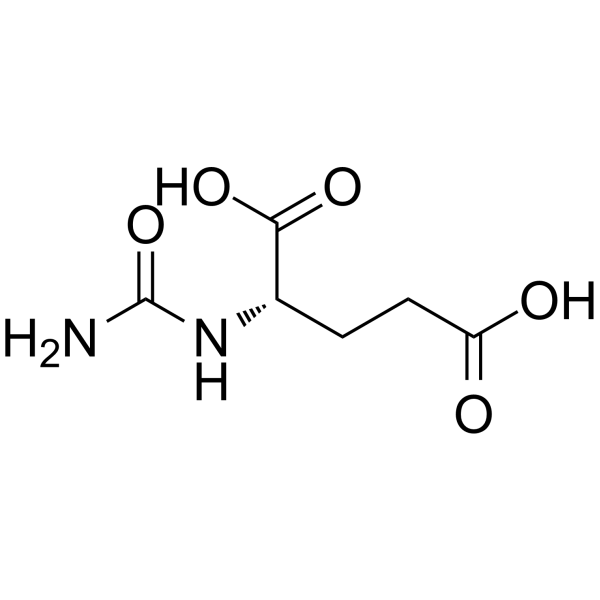上海金畔生物科技有限公司为生命科学和医药研发人员提供生物活性分子抑制剂、激动剂、特异性抑制剂、化合物库、重组蛋白,专注于信号通路和疾病研究领域。
Carglumic Acid (Synonyms: N-Carbamyl-L-glutamic acid) 纯度: ≥98.0%
Carglumic acid (N-Carbamyl-L-glutamic acid) 是 N-乙酰谷氨酸 (NAG) 的功能类似物和氨甲酰磷酸合成酶 1 (CPS1) 的活化剂,用于研究与 N-乙酰谷氨酸合成酶 (NAGS) 缺陷相关的急性和慢性高氨血症。

Carglumic Acid Chemical Structure
CAS No. : 1188-38-1
| 规格 | 价格 | 是否有货 | 数量 |
|---|---|---|---|
| Free Sample (0.1-0.5 mg) | Apply now | ||
| 10 mM * 1 mL in DMSO | ¥550 | In-stock | |
| 200 mg | ¥500 | In-stock | |
| 500 mg | ¥900 | In-stock | |
| 1 g | ¥1200 | In-stock | |
| 5 g | 询价 | ||
| 10 g | 询价 |
* Please select Quantity before adding items.
Carglumic Acid 相关产品
•相关化合物库:
- Drug Repurposing Compound Library Plus
- FDA-Approved Drug Library Plus
- FDA-Approved Drug Library Mini
- Bioactive Compound Library Plus
- FDA-Approved Drug Library
- Anti-Cancer Compound Library
- Peptidomimetic Library
- Drug Repurposing Compound Library
- Anti-COVID-19 Compound Library
- Orally Active Compound Library
- FDA Approved & Pharmacopeial Drug Library
- Anti-Breast Cancer Compound Library
- Anti-Pancreatic Cancer Compound Library
- Rare Diseases Drug Library
| 生物活性 |
Carglumic acid (N-Carbamyl-L-glutamic acid), a functional analogue of N-acetylglutamate (NAG) and a carbamoyl phosphate synthetase 1 (CPS1) activator, is used to treat acute and chronic hyperammonemia associated with NAG synthase (NAGS) deficiency. |
IC50 & Target |
CPS1[1] |
||||||||||||||
|---|---|---|---|---|---|---|---|---|---|---|---|---|---|---|---|---|---|
| 体外研究 (In Vitro) |
Carglumic acid suppresses cell viability in the pancreatic ductal adenocarcinoma cell lines, triple-negative breast cancer cell lines, hepatoma cell lines, and human non-small cell lung carcinoma cell lines in a dose-dependent manner. The 50% inhibitory concentration (IC50) of Carglumic acid against those cell lines is between 5 and 7.5 mM. The results show that Carglumic acid does not induce complete cell cycle arrest. Instead, there are more sub-G1 cells among Carglumic acid-treated AsPC1 and MDA-MB-231 cells than among untreated cells. In AsPC1 and HPDE-E6E7 cells, the IC50s of Carglumic acid are 5 mM and over 10 mM, respectively . In MDA-MB-231 and MCF-12A cells, the IC50s of Carglumic acid are 5 mM and 6 mM, respectively[1]. 上海金畔生物科技有限公司 has not independently confirmed the accuracy of these methods. They are for reference only. |
||||||||||||||||
| 体内研究 (In Vivo) |
The results show that Carglumic acid, but not the vehicle control, markedly inhibits tumor growth. In the orthotopic pancreatic cancer model, tumor growth inhibition by Carglumic acid on day 21 is 80% (P<0.01). In the orthotopic triple-negative breast cancer model, tumor growth inhibition by Carglumic acid on day 20 is 82% (P<0.01). These results indicate that Carglumic acid suppresses tumor growth in pancreatic cancer and triple-negative breast cancer. On day 20, mean tumor growth inhibition in orally and intravenously treated mice is 55% and 93%, respectively, relative to untreated mice (P<0.01)[1]. 上海金畔生物科技有限公司 has not independently confirmed the accuracy of these methods. They are for reference only. |
||||||||||||||||
| Clinical Trial |
|
||||||||||||||||
| 分子量 |
190.15 |
||||||||||||||||
| Formula |
C6H10N2O5 |
||||||||||||||||
| CAS 号 |
1188-38-1 |
||||||||||||||||
| 中文名称 |
卡谷氨酸 |
||||||||||||||||
| 运输条件 |
Room temperature in continental US; may vary elsewhere. |
||||||||||||||||
| 储存方式 |
|
||||||||||||||||
| 溶解性数据 |
In Vitro:
DMSO : 100 mg/mL (525.90 mM; Need ultrasonic) H2O : 8.33 mg/mL (43.81 mM; Need ultrasonic) 配制储备液
*
请根据产品在不同溶剂中的溶解度选择合适的溶剂配制储备液;一旦配成溶液,请分装保存,避免反复冻融造成的产品失效。 In Vivo:
请根据您的实验动物和给药方式选择适当的溶解方案。以下溶解方案都请先按照 In Vitro 方式配制澄清的储备液,再依次添加助溶剂: ——为保证实验结果的可靠性,澄清的储备液可以根据储存条件,适当保存;体内实验的工作液,建议您现用现配,当天使用; 以下溶剂前显示的百
|
||||||||||||||||
| 参考文献 |
|
| Kinase Assay [1] |
Caspase activity is measured by using a fluorimetric caspase-3 assay kit. In brief, cells that are treated with Carglumic Acid or that are left untreated are lysed in a lysis buffer, and 50 μg of protein lysate is incubated with Ac-DEVD-AMC substrate in the assay buffer for 1 h. The resultant fluorescence signals are read by using a fluorometer (excitation 360 nm, emission 460 nm), and the results are tabulated as fold changes relative to the untreated control cells[1]. 上海金畔生物科技有限公司 has not independently confirmed the accuracy of these methods. They are for reference only. |
|---|---|
| Cell Assay [1] |
Cell viability is evaluated by MTT (3-(4,5-dimethylthiazol-2-yl)-2,5-diphenyltetrazolium bromide) assay. In brief, various cancer cell lines are seeded (1×104 cells/well) in a 96-well plate and treated with different doses of Carglumic Acid. After 48 h, 50 μL of MTT solution per well (stock solution concentration 5 mg/mL) is added to each well, and the cells are incubated for 2 h more, followed by addition of 100 μL of dimethyl sulfoxide to each well. Absorbance at 570 nm is measured immediately using a multiwell scanner[1]. 上海金畔生物科技有限公司 has not independently confirmed the accuracy of these methods. They are for reference only. |
| Animal Administration [1] |
For orthotopic cancer models, AsPC1/luc human pancreatic cancer cells (1×106) are injected into the pancreas of nude mice or MDA-MB-231 human triple-negative breast cancer cells (3×106) are injected into the mammary fat pad of nude mice. Carglumic acid is administered to mice 5 days after tumor inoculation in the pancreatic cancer model and 7 days after tumor inoculation in the triple-negative breast cancer model. Tumor-bearing mice receive a Carglumic acid dose of 120 mg/kg orally every day for 10 days, 60 mg/kg orally three times per week for 2 weeks, or 60 mg/kg intravenously three times per week for 2 weeks. Tumor volume is determined by measuring luciferase signals using the in vivo imaging system in the pancreatic cancer model[1]. 上海金畔生物科技有限公司 has not independently confirmed the accuracy of these methods. They are for reference only. |
| 参考文献 |
|
所有产品仅用作科学研究或药证申报,我们不为任何个人用途提供产品和服务
